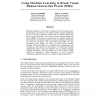Free Online Productivity Tools
i2Speak
i2Symbol
i2OCR
iTex2Img
iWeb2Print
iWeb2Shot
i2Type
iPdf2Split
iPdf2Merge
i2Bopomofo
i2Arabic
i2Style
i2Image
i2PDF
iLatex2Rtf
Sci2ools
NIPS
2004
2004
Using Machine Learning to Break Visual Human Interaction Proofs (HIPs)
Machine learning is often used to automatically solve human tasks. In this paper, we look for tasks where machine learning algorithms are not as good as humans with the hope of gaining insight into their current limitations. We studied various Human Interactive Proofs (HIPs) on the market, because they are systems designed to tell computers and humans apart by posing challenges presumably too hard for computers. We found that most HIPs are pure recognition tasks which can easily be broken using machine learning. The harder HIPs use a combination of segmentation and recognition tasks. From this observation, we found that building segmentation tasks is the most effective way to confuse machine learning algorithms. This has enabled us to build effective HIPs (which we deployed in MSN Passport), as well as design challenging segmentation tasks for machine learning algorithms.
| Added | 31 Oct 2010 |
| Updated | 31 Oct 2010 |
| Type | Conference |
| Year | 2004 |
| Where | NIPS |
| Authors | Kumar Chellapilla, Patrice Y. Simard |
Comments (0)

